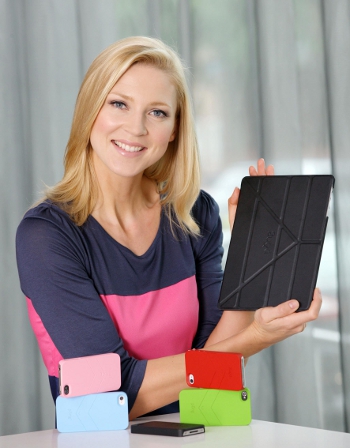The iPhone 4S modelling the red Pong smartphone cover
Today in Ireland, Pong Research Corporation has launched its range of iPad and smartphone cases that claim to improve signal strength, maintain battery life and protect users against exposure to cellular and Wi-Fi radiation – so myself and Siliconrepublic.com editor John Kennedy put them to the test.
Radiation from mobile phones has been listed as a possible carcinogen by the World Health Organisation and Pong Research claims that more than 50pc of the radiation emitted by phones can be absorbed by users’ heads and bodies.
Pong smartphone covers are embedded with a multi-patented micro-thin antenna, which has been developed by a team of scientists from MIT, Princeton, Harvard and UCLA – some of the top universities in the US.
This antenna deflects radiation away from users and, in doing so, allows more radiation to communicate with cell towers, therefore optimising the phone’s signal. The phone’s battery life is also improved as less signal (and, therefore, less power) is required to communicate.
Protective technology for cautious users
“This is game-changing technology and we are really excited to be bringing the product to Ireland following the huge success in the US,” said Richard Pearson, owner of Pong Ireland. “Pong have developed the only scientifically proven technology that deals with the much-publicised problem of mobile radiation exposure, while improving device signal strength and battery life which a normal case can, in fact, inhibit.”

While Pearson acknowledges the debate on radiation and potential health consequences is up in the air, he finds many users simply like to be cautious.
“We have found that many would like the peace of mind to protect themselves and their children while the research continues,” he said. “This ‘precautionary principle’ is now being supported by international governments and agencies worldwide.”
Putting Pong through its paces
Available in 55 countries, Pong smartphone and iPad covers are now available in Ireland from the Pong Ireland website, with prices starting at €49.99.
Myself and Kennedy were recently given covers for the iPhone 4S and the Samsung Galaxy S II to trial and, though we obviously can’t tell if we were any less exposed to radiation, we still noted some of the benefits of the Pong cases.
After using the case for a week, I have noticed that my battery does seem to last a bit longer than it used to. As far as improved signal, though, I can’t be certain. The speed of uploads and downloads seemed the same as ever, though I was happy to see my signal was maintained even when away camping for the weekend.
“While I haven’t noticed any discernible increase in battery life or signal boost, I have to say it accomplishes the role of protecting my iPhone 4S and making it look good at the same time,” said Kennedy. “Few covers manage this without bulking up the size of the smartphone but, thankfully, my device is kept nice and slim.”
The case for the Samsung Galaxy S II isn’t the best of the Pong range, and I must admit the iPhone version looked far superior.
“The cover I’m using is in a glorious red and I’m happy that my brain isn’t being fried by wireless waves,” Kennedy added.
Verdict
So, while many of the benefits of Pong cases are difficult to measure without lab testing, we were both happy with the durable protection, shock absorption and scratch protection afforded by the covers.
If mobile phone radiation is a potential health hazard, it’s reassuring to be able to protect yourself while still having a phone that looks good. The cases are easy to slip on and off, they don’t take up too much extra space, and the range of colours available makes it easy to find one to suit you.
Pong cases are available for iPhone, Samsung, HTC, Motorola and BlackBerry smartphones, as well as the iPad.